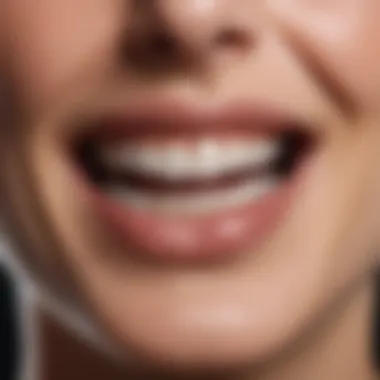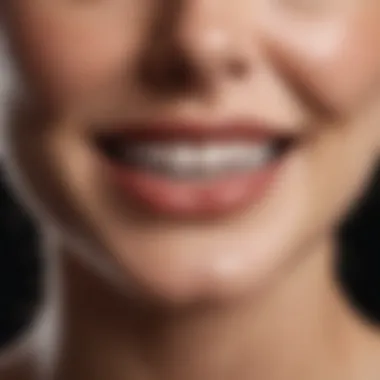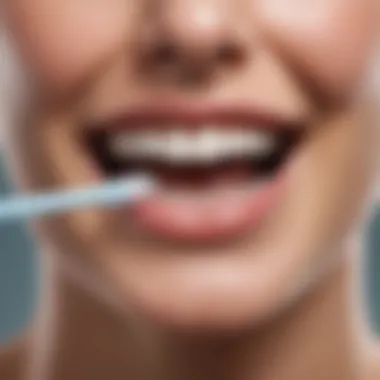Permanent Retainers: Essential Guide for Upper Teeth


Intro
Obtaining a permanent retainer for your upper teeth is an important decision. Many people may not fully understand all implications that come with this orthodontic option. This article aims to clarify what permanent retainers are, how they are installed, and what maintenance involves. It also discusses the advantages and disadvantages, making sure to answer common questions. By providing a detailed analysis, we will help readers understand all necessary aspects before making a choice.
Understanding Permanent Retainers
A permanent retainer is a small wire fixed to the back of your teeth. Its primary purpose is to keep teeth in place after orthodontic treatment. This is often crucial for preventing teeth from shifting back to their original position. Patients who have undergone braces are most common users of these retainers. They serve as a reliable option for ensuring long-term stability.
Procedural Requirements for Installation
Before the installation of a permanent retainer, there are several steps involved. First, an orthodontist will assess your specific dental structure. This assessment includes taking X-rays and impressions of your teeth. Once the examination is complete, the orthodontist will bond the retainer to the back of the front teeth. This process mainly involves the use of a dental adhesive that secures the wire effectively. It is often completed in a single session, taking around thirty minutes.
Maintenance Protocols
Maintaining a permanent retainer is essential for ensuring its effectiveness. Patients are advised to practice good dental hygiene. Here are some key maintenance tips:
- Use a soft toothbrush to clean around the retainer.
- Floss daily to remove food particles trapped in the wire.
- Regular visits to your dentist for check-ups is important.
Proper maintenance ensures the longevity of your retainers and helps prevent oral issues such as cavities or gum disease.
Benefits and Drawbacks
Permanent retainers come with both advantages and disadvantages. On the positive side, they provide constant support to keep teeth aligned. This makes them a reliable option, compared to removable ones. Patients do not have to worry about taking them out or misplacing them.
However, there are some drawbacks. Permanent retainers can be challenging to clean. Food particles can become stuck, leading to potential dental issues. They may also create discomfort for some users initially. Understanding these factors is key for anyone considering this orthodontic treatment.
Alternatives to Permanent Retainers
There are alternatives for those who are not suited for permanent retainers. Removable retainers, such as Hawley or clear plastic types, are popular options. These allow for easier cleaning and give patients more control. However, they require discipline to ensure regular wearing for effectiveness.
Frequently Asked Questions
Many patients have questions regarding permanent retainers. Here are some of the most common inquiries:
- How long do permanent retainers last?
They can last for many years, but regular check-ups are crucial. - Can I eat with a permanent retainer?
Yes, but it is advisable to avoid sticky or hard foods that may damage the retainer. - Will I feel pain after installation?
Some discomfort may be common, but it usually resolves within a few days.
Understanding permanent retainers is vital for making informed choices about orthodontic care. This guide aims to present a foundational understanding of retainers. It tackles both practical and orthodontic implications, ensuring readers have comprehensive knowledge before proceeding.
Prolusion to Permanent Retainers
The topic of permanent retainers is crucial for anyone considering long-term orthodontic solutions. They are often an essential part of post-orthodontic treatment, especially after braces. Understanding how these devices function can help people make informed decisions about their oral health.
Understanding Permanent Retainers
Permanent retainers are thin wires bonded to the back of the teeth. They are designed to keep teeth in place after braces have been removed. Unlike removable retainers, which need to be put on and taken off regularly, permanent retainers provide a continuous hold. This constant pressure helps to prevent teeth from shifting back to their original positions.
The material used for permanent retainers typically includes stainless steel or another durable metal. This makes them robust and effective over extended periods. Over time, the bonding material can degrade, which is why proper dental check-ups and care are essential to maintain their effectiveness.
Purpose of Permanent Retainers
The primary purpose of permanent retainers is to maintain teeth alignment after the removal of braces. Many individuals experience some degree of tooth shifting naturally over time, making retainers necessary for maintaining that alignment.
Permanent retainers have several key benefits:
- Long-term Alignment: They help stabilize teeth and prevent relapse, which is when teeth move back to their original positions.
- Discrete Appearance: Since they are bonded behind the teeth, they are virtually invisible, making them a popular choice for people who want to keep their orthodontic work discreet.
- Convenience: Unlike removable retainers, individuals do not need to remember to put them in or take them out. This ease of use is particularly beneficial for maintaining consistent oral health habits.


While the advantages are clear, one must consider factors like maintenance and potential risks involved with permanent retainers. These aspects will be discussed in further detail later in the article.
Eligibility for Permanent Retainers
Determining eligibility for permanent retainers is a pivotal step in the orthodontic journey. Permanent retainers provide a reliable means to maintain teeth alignment after undergoing treatment. Understanding who qualifies for these retainers can assist individuals in making informed decisions about their oral health. This section outlines essential factors that influence eligibility, along with the necessity of consulting an orthodontist for tailored advice.
Factors Influencing Eligibility
Several factors influence whether an individual can receive a permanent retainer. Recognizing these can provide clarity about personal options and expectations. Key factors include:
- Dental Condition: The overall health of your teeth and gums plays a significant role. Conditions such as severe gum disease or cavities may complicate or disqualify candidates for permant retainers.
- Previous Orthodontic Work: The nature of prior orthodontic treatments is important. Those who have had extensive orthodontic work or specific types of braces may be more suited for retainers.
- Age: Age can influence eligibility as well. Younger individuals might still experience tooth movement, making a permanent solution less ideal. Professionals often evaluate patients on a case-by-case basis.
- Tooth Position: The positioning of teeth prior to treatment also matters. For those with a substantial misalignment, orthodontic treatment could be necessary before considering a permanent retainer.
- Patient Compliance: Individuals need to demonstrate a commitment to oral hygiene and post-treatment care. A responsible patient is more likely to qualify for a permanent retainer.
This list encompasses some primary elements but does not cover all potential situations. Each case presents its own unique circumstances requiring professional evaluation.
Consultation with an Orthodontist
The value of consulting with an orthodontist cannot be overstated. This step entails a thorough examination to better understand personal dental needs. During the consultation, the orthodontist will:
- Evaluate Dental Health: A comprehensive analysis will include looking at tooth alignment, gum condition, and any existing orthodontic work.
- Discuss Options: The orthodontist will outline suitable options, which may include permanently installed retainers while detailing the pros and cons.
- Treatment Planning: If found eligible, an individualized treatment plan will be designed. Factors related to the patient's lifestyle, age, and dental history will be factored into this plan.
- Address Concerns: Take this opportunity to address any concerns or answer questions regarding the procedure, maintenance, or potential risks.
The Procedure of Getting a Permanent Retainer
Getting a permanent retainer involves several key stages. Each stage plays a crucial role in ensuring the retainer is fitted correctly and serves its purpose effectively. Understanding this process can help alleviate any concerns you might have about the procedure, as well as prepare you for what lies ahead.
Initial Assessment and Planning
The first step in the procedure is the initial assessment conducted by your orthodontist. This evaluation is vital for the proper planning of your treatment. During this stage, the orthodontist will examine your teeth and overall oral health. They might take X-rays and create a mold of your teeth to understand your alignment and needs better.
This assessment helps in determining your eligibility for a permanent retainer. If your teeth are well-aligned but need support to stay that way, a permanent retainer may be the right choice. Your orthodontist will discuss any issues they find and provide options tailored to your individual needs.
Installation Process Explained
Once your orthodontist confirms that you are a suitable candidate, the actual installation process begins. It typically takes about one hour. You will be seated comfortably in the dental chair.
The process starts with the teeth being cleaned and dried. After this, the orthodontist will apply a special bonding material to the back of your teeth. This material is then set into place with the help of a curing light, ensuring that it adheres well. After the bonding material is applied, a thin wire will be attached. This wire is the main component of the permanent retainer. It is secured in place by additional bonding material.
Finally, the orthodontist will ensure that everything is comfortable and adjust the position if necessary. This step is crucial in preventing discomfort and ensuring the retainer functions as intended.
What to Expect Post-Procedure
After the installation, it is normal to feel some discomfort. This sensation usually subsides in a matter of days. However, you should be able to eat and speak normally shortly after the procedure. Here are a few things to keep in mind:
- Oral Hygiene: It is essential to maintain strict oral hygiene after getting a permanent retainer. Brushing and flossing will require a bit more care, but it is critical for preventing plaque buildup.
- Follow-up Visits: Regular check-ups with your orthodontist are necessary to ensure everything is functioning correctly. This allows them to make adjustments if needed and address any concerns you might have.
- Diet Considerations: Initially, you may want to avoid hard or sticky foods that can damage the retainer. Your orthodontist may provide specific guidelines for dietary choices post-installation.
Remember, the key to the success of a permanent retainer is diligent care and regular orthodontist visits.
Understanding the procedure of getting a permanent retainer is crucial for making informed decisions about your orthodontic care. Knowing what to expect can ease any anxiety and help ensure long-term success.
Maintenance of Permanent Retainers
Maintaining a permanent retainer is crucial for ensuring its effectiveness and longevity. Proper maintenance not only prolongs the life of the retainer but also significantly contributes to the overall health of your teeth and gums. Given that these retainers play an important role in keeping the teeth aligned following orthodontic treatment, neglecting their care could lead to dental issues, including potential misalignment or decay.
A structured maintenance routine for permanent retainers involves a combination of daily care habits and regular professional check-ups. Both these practices help mitigate risks associated with retainers and ensure optimal gum health.
Daily Care and Hygiene Practices


Routine care is necessary for the upkeep of your permanent retainer. Here are key habits to adopt in your daily routine:
- Brushing: Brush your teeth regularly, preferably twice a day, using fluoride toothpaste. Make sure to clean around the retainer, as plaque can build up in areas that are harder to reach.
- Flossing: Flossing becomes even more essential with a permanent retainer in place. Use a floss threader or orthodontic floss to help navigate between your teeth and the retainer without causing damage.
- Rinsing: Using an antibacterial mouthwash can help reduce plaque and keep the area around the retainer fresh and clean.
By adhering to these daily hygiene practices, you can significantly reduce the risks of gum disease or tooth decay, which can otherwise stem from a build-up of plaque or bacteria.
Regular care is vital for permanent retainers to maintain both function and health.
Regular Check-Ups with an Orthodontist
In addition to personal hygiene, scheduling periodic visits with an orthodontist is essential. During these visits, the orthodontist will evaluate the condition of the retainer and make any necessary adjustments. Here’s what you can expect during these check-ups:
- Evaluation: The orthodontist will check for any signs of wear, damage, or plaque buildup on the retainer.
- Adjustments: If needed, adjustments can be made to ensure that the retainer is aligned properly and functioning as intended.
- Professional Cleaning: Many orthodontists offer professional cleaning services for retainers to eliminate plaque that may not be routinely removed at home.
By maintaining regular appointments, you can ensure your permanent retainer remains effective and your dental health is safeguarded.
Potential Benefits of Permanent Retainers
Permanent retainers serve as a cornerstone in the realm of orthodontics, particularly after the removal of braces. Understanding their benefits can be crucial for those considering this option. From long-term alignment to the aesthetics of discreet wear, these retainers offer practical solutions that cater to both dental health and lifestyle needs.
Long-term Teeth Alignment
One of the primary advantages of permanent retainers is their ability to maintain teeth alignment over extended periods. After braces are removed, there is often a tendency for teeth to shift back toward their original positions. Permanent retainers help mitigate this risk effectively. They provide a constant force that keeps teeth in their corrected spots.
Patients can generally expect that these devices will function well for several years, if not a lifetime. Research suggests that the longer teeth are stabilized post-braces, the less likely they are to relapse into misalignment. Permanent retainers, when fitted correctly, significantly reduce the chances of such issues.
The consistency of wear also minimizes the need for additional orthodontic treatment in the future. Thus, investing in a permanent retainer can save both time and costs down the line.
Discreet Orthodontic Solution
Another notable benefit is the discreet nature of permanent retainers. Unlike traditional removable retainers, which can be cumbersome and require adherence to a strict wear schedule, permanent retainers remain fixed to the teeth. This aspect is particularly appealing to adult patients or those who prefer not to let others know they are wearing a retainer.
The materials used for these retainers are often tooth-colored or otherwise designed to blend in seamlessly with natural teeth. As a result, wearers can feel more confident in social situations, not worrying about visibility or the need to remember to wear them.
Furthermore, the simplicity of not having to manage removable devices can lead to better compliance in wearing retainers. The ease of having a permanent solution allows individuals to continue with their daily routines without interruption, ensuring that their orthodontic treatment yields its maximum potential.
Overall, the permanence and discretion provided by these retainers revolutionize how individuals perceive orthodontic aftercare.
Drawbacks and Considerations
Examining the drawbacks and considerations related to permanent retainers is essential for anyone contemplating this option. While permanent retainers offer benefits such as long-term stability in teeth alignment, they come with certain risks and financial implications that should not be overlooked. By understanding these factors, individuals can make informed decisions that align with their orthodontic needs and expectations.
Risks of Permanent Retainers
One significant risk associated with permanent retainers is the potential for oral hygiene challenges. Since these retainers are bonded to the teeth, they may trap food particles and plaque more readily than removable options. This increases the risk of cavities and gum disease if proper dental care is not maintained. It is crucial to adapt daily brushing and flossing techniques to effectively clean around the retainer.
Moreover, there is also a possibility of the retainer becoming loose or breaking. A dislodged retainer can lead to misalignment of the teeth, necessitating a visit to the orthodontist for repairs. This might cause inconvenience or additional costs, depending on the scenario.
Another concern is discomfort or irritation caused by the retainer, especially in the initial weeks after its placement. Some patients experience soreness in their gums, which may require time to adjust.
Cost Considerations
The financial aspect of obtaining a permanent retainer warrants careful thought. The upfront cost can vary widely, depending on factors like the orthodontist's expertise, location, and the complexity of the case. Typically, the expense ranges from several hundred to over a thousand dollars. This price generally covers the installation, but it is important to note that ongoing maintenance and possible repairs may incur additional costs in the future.
Many dental insurance plans offer coverage for orthodontic services, but specifics can differ. Individuals should check with their insurers for details regarding coverage limits, copays, and whether retainers are part of their benefits.


"Investing in a permanent retainer is not just a choice for today; it's a decision that impacts your dental health for years to come."
As you reflect on your options, consider both the potential benefits and challenges of permanent retainers and how they align with your long-term oral health goals.
Comparing Retainer Options
When considering orthodontic solutions, it's crucial to assess the differences and benefits between various retainer types. Permanent retainers are not the only option available for maintaining tooth alignment. Understanding the nuances of permanent vs. removable retainers helps individuals make informed decisions tailored to their specific dental needs and lifestyles. Each type has unique characteristics, benefits, and limitations. An appropriate retainer can significantly influence long-term dental health and overall satisfaction with orthodontic treatment.
Permanent vs. Removable Retainers
Permanent retainers are made from a thin wire bonded directly to the back of the teeth. They offer a discrete option for individuals seeking long-term stabilization. Their primary advantage lies in their non-removable nature, which ensures that teeth remain aligned without any effort from the patient. This is especially beneficial for those who may forget to wear a removable retainer or can struggle with maintaining routine.
In contrast, removable retainers, such as the Essix or Hawley types, can be taken out during eating, brushing, or flossing. They allow for greater flexibility and ease of maintenance. Users can ensure better oral hygiene, as these retainers can be cleaned separately. However, a significant drawback is the responsibility placed on the wearer to remember to put them back in after removal. Failure to do so can lead to unwanted tooth movement.
Both types of retainers are effective if used properly, but they cater to different lifestyles and preferences. Here are some distinguished aspects of each:
- Maintenance:
- Longevity:
- Comfort:
- Permanent retainers require consistent oral hygiene practices, but no daily management aside from regular cleaning.
- Removable retainers necessitate daily wear for effectiveness and require cleaning routines that can be forgettable.
- Permanent retainers can last for years, often requiring replacement only if damage occurs.
- Removable retainers may need to be replaced more frequently due to wear and tear or loss.
- Some individuals may find permanent retainers less noticeable after getting used to them.
- Removable retainers may initially feel bulky but can be adjusted for comfort.
Which Option Suits You Best?
Determining the most suitable retainer depends on personal circumstances, oral health, and orthodontic history. If you tend to misplace items or have any concerns regarding diligently using a removable retainer, a permanent retainer may be more suitable.
On the other hand, if you prefer the ability to remove your retainer for enhanced cleaning or comfort, a removable option may suit you better.
It’s recommended to consult with an orthodontist who will assess individual needs and circumstances, ensuring optimal alignment results and retention of that flawless smile. Factors to consider include:
- Lifestyle: Assess daily routines and destress options. Do you travel often? A permanent retainer might suit a busy lifestyle better.
- Oral Health: A thorough evaluation of existing conditions can highlight which retainer type aligns with those needs.
- Aesthetic Preferences: Consider how visible you want your retainer to be, as discreet options can influence choice.
Ultimately, the key to successful post-orthodontic treatment lies in a retainer that best fits personal habits and lifestyle. Clarity in this choice can enhance satisfaction with orthodontic results.
Frequently Asked Questions
The section on frequently asked questions plays a critical role in providing clarity and addressing common concerns many people have about permanent retainers. By consolidating these queries, the article serves as a valuable resource, directly answering the most pressing issues faced by individuals considering this orthodontic option. This not only aids decision-making but also alleviates anxieties surrounding the process and maintenance of retainers. Understanding the answers to these questions can greatly enhance the overall experience of undergoing treatment and managing aftercare effectively.
Can get a permanent retainer on my top teeth?
Yes, it is possible to get a permanent retainer on your top teeth. However, the appropriateness of this option depends on various factors, including your dental alignment and the recommendation of your orthodontist. Permanent retainers are often placed on the back of the front teeth to maintain their position. This option is especially beneficial for individuals who have undergone orthodontic treatment and want to avoid shifting. It is essential to have an in-depth consultation with a qualified orthodontist to evaluate your specific dental needs and ensure that a permanent retainer is the most suitable option for you.
How long will need to keep my retainer?
The duration for which you need to keep a permanent retainer will vary based on individual circumstances. Most orthodontists recommend keeping the retainer for an extended period, often a few years, or even indefinitely, if necessary. The primary goal is to maintain the alignment gained through previous orthodontic treatment. Some people may need to wear the retainer longer if they notice any shifting or misalignment with their teeth over time. Regular check-ups with your orthodontist can help in determining how long you should continue wearing the retainer.
What happens if my retainer breaks?
If your permanent retainer breaks, it is crucial to address the issue promptly. A broken retainer can lead to teeth shifting back to their original misaligned positions. If you suspect that your retainer has broken, contact your orthodontist immediately. They can assess the damage and determine whether repair or replacement is needed. In the meantime, be careful with the affected area to avoid any discomfort. Regular maintenance and check-ups can help prevent such incidents and ensure your retainer remains intact.
Finale
In this article, we explored the multifaceted nature of permanent retainers, particularly for the upper teeth. Understanding the intricacies surrounding this orthodontic solution is crucial for making informed decisions about dental health.
Key Aspects to Consider:
- Long-term Benefits: Permanent retainers significantly aid in maintaining teeth alignment over time. For individuals who have undergone extensive orthodontic treatment, this aspect cannot be overstated. Keeping teeth in place is essential to retain the results achieved through braces or other corrective measures.
- Maintenance Requirements: Regular check-ups with an orthodontist and diligent daily care are essential for ensuring the longevity of permanent retainers. Misalignment or damage can lead to complications, making it imperative to follow these guidelines closely.
- Cost Implications: While initial costs may seem high, weighing them against the long-term benefits can offer a different perspective. Budgeting for orthodontic care should take into account the necessity of maintaining dental health over the years.
- Comparative Analysis: The choice between permanent and removable retainers often hinges on individual lifestyle and dental needs. Understanding these differences can aid prospective users in selecting the most fitting option.
In summary, the insights compiled throughout this article present a thorough examination of permanent retainers. Individuals considering this orthodontic solution gain valuable knowledge, allowing them to navigate their options effectively. Maintaining healthy teeth is not just about aesthetics; it impacts overall well-being. A permanent retainer might just be the solution that provides peace of mind and lasting results for many.







